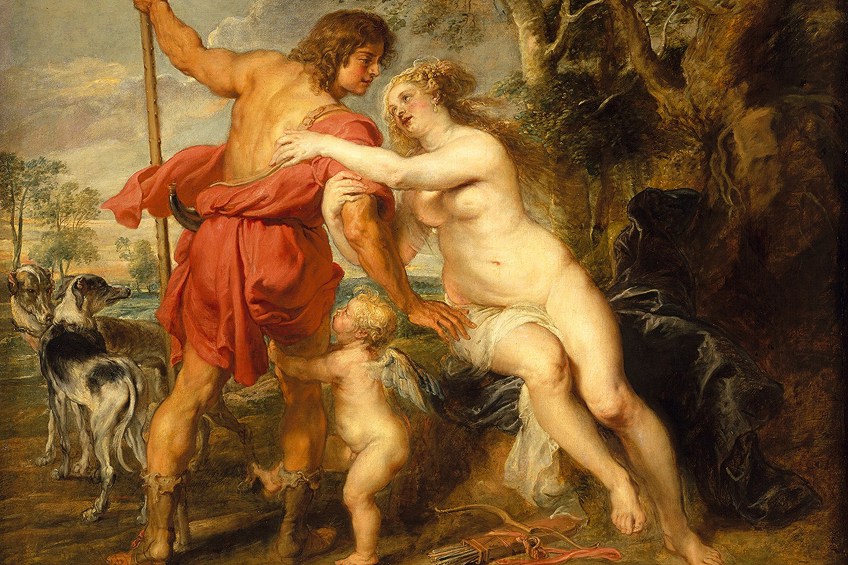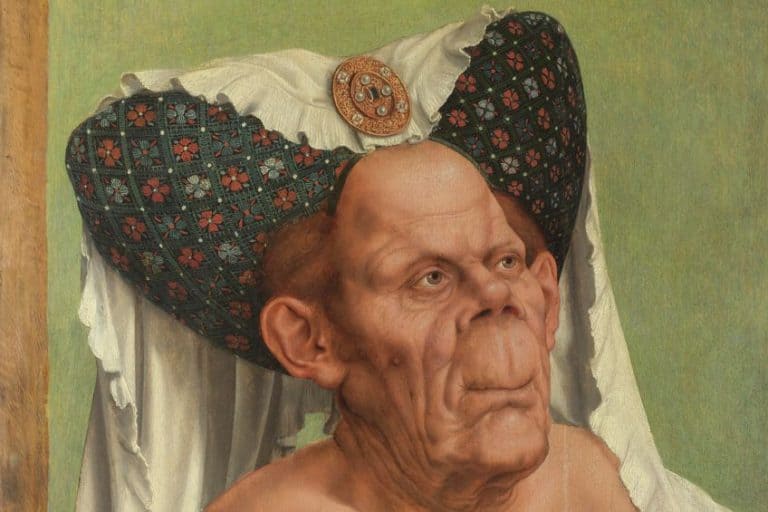Peter Paul Rubens Paintings – The Best Rubens’ Artworks
A prominent artist who rose to fame during the Dutch Golden Age of art was Peter Paul Rubens (1577-1640). Widely believed to be the most distinguished and noteworthy artist of the Flemish Baroque tradition, Rubens created mostly history paintings and drawings that centered around religious and mythological subjects. When considering his artworks, Rubens was famously known for his effortless blend of the Flemish realism style with that of the Italian Renaissance. Below, we will be discussing some of his most significant artworks ever made.
Who Was Peter Paul Rubens?
After the Renaissance period had ended, the art world experienced another striking change in terms of its style as the Baroque period was introduced. A significant artist to emerge from this time was Flemish painter Peter Paul Rubens, who went on to create remarkably flamboyant artworks that were filled with color, passion, movement, and spectacle.
In addition to being a prolific artist, Rubens was a diplomat and a well-read humanist scholar, which led to him being knighted by Philip IV of Spain and Charles I of England.
Born in Seigen, which was part of the Holy Roman Empire at the time, Rubens moved to Antwerp with his family in 1589. It was there that he displayed a tremendous talent for art and began apprenticeships with several artists who were working in the Mannerist style. After completing his studies in 1598, Rubens was seen as an independent master painter and began traveling to Italy. There, he studied the works of Renaissance masters like Titian, Raphael, Michelangelo, and Caravaggio, whose artworks all impacted his own style greatly.

In 1609, Rubens became the court painter of Albert VII, Archduke of Austria, and Infanta Isabella Clara Eugenia of Spain, whose patronage he would remain in for the remainder of his life. While he was valued as the court painter, Rubens was also a highly regarded court diplomat and often carried out information-gathering endeavors on behalf of the royal family, receiving numerous special privileges for both of these roles. In 1610, he moved into a house in Antwerp which would become his studio and later, turned into the Rubenshuis Museum.
As one of the most influential painters to emerge from the Flemish Baroque period, Rubens was seen as a master when it came to his dynamic compositions.
In terms of praises, Rubens received an honorary master’s degree from Cambridge University in 1629 and in 2002, his Massacre of the Innocents (1611 – 1612) painting sold for $76.2 million at a Sotheby’s auction shortly after it was recovered. By the end of 2013, this was still the highest documented auction price for an Old Master painting ever sold.
Typical Characteristics Within Rubens’ Drawings and Paintings
Rubens is mostly known for his extremely tense compositions that made reference to specific features of both classical and Christian history. Sticking to portraits, landscapes, and altarpieces, Rubens made use of mythological and allegorical subjects to give a real insight into the issues that plagued the type of society he lived in at the time. Within Rubens’ energetic paintings, his distinct style of intensified color, motion, and drama was revealed.
These all proved to be essential features of Baroque art, which we will be looking at below.
Voluptuous Female Nudes
The depiction of female nudes was incredibly popular within Baroque art, especially when used in the illustrations of mythological scenes. Rubens became very well-known for the way he depicted women in his paintings, as he mainly chose to paint soft-bodied and curvaceous women. Rubens was later considered to be the perfect example of the “gentleman” artist, as he became the archetype of the ultimate professional artist who was able to easily move between artistic and political circles.
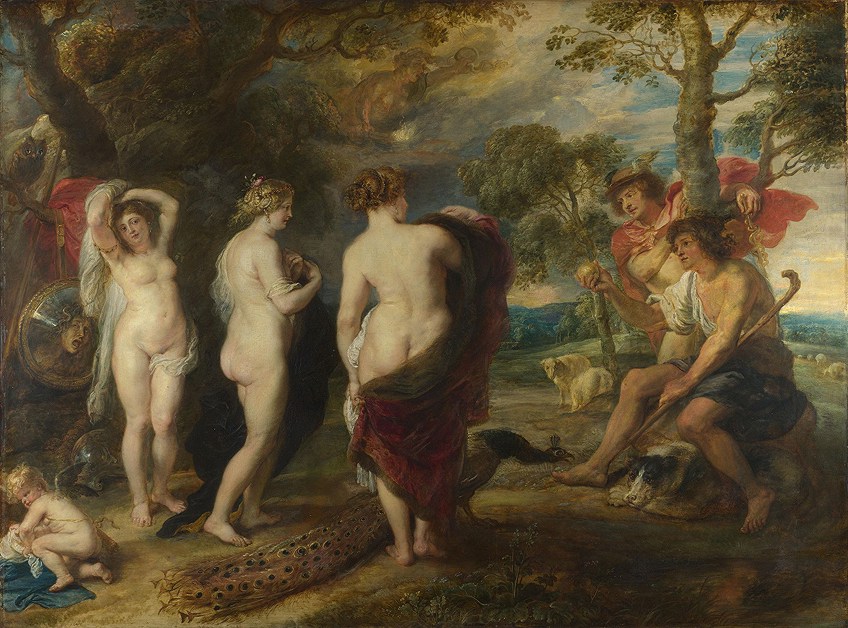
Rubens’ signature depiction of the female forms eventually led to the term “Rubenesque” developing, which was used to describe the certain way he painted his voluptuous nudes. Today, this remains a widely recognized term and is still used to describe any shapely nudes. Rubens also applied his unique style to his depiction of male nudes; however, it was vastly different.
He typically painted men as large, brawny, and powerful figures that reminded viewers of the characters that the great Michelangelo painted on the Sistine Chapel ceiling.
Color
In addition to his depiction of the female form, Rubens was a great believer in color. As a fan of Italian Renaissance artist Titian and the Venetian manner of painting, Rubens chose to highlight color over drawing in all his paintings. He employed this style in his Baroque artworks and went on to use vivid colors that intensified the richness and drama in his works.
Movement
Through his manipulation of the human form, Rubens was able to create captivating paintings that were filled with vigor and action. As most of his paintings featured groups of individuals, Rubens was able to capture the essence of movement through portraying twisting figures. This also formed different visual routes for viewers to follow, as it gave them the feeling that the narration of the painting was developing right in front of them.
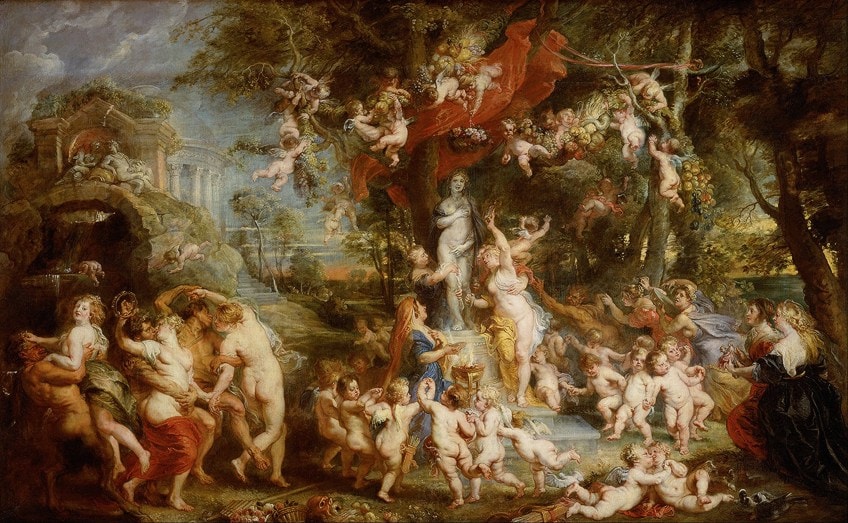
Our Top 12 Most Famous Peter Paul Rubens Paintings
Throughout his career, Rubens created many prolific paintings that are still spoken about today. As a court painter, he was appointed to create many paintings of the royal family in addition to his everyday commissions of portraits and landscapes. Rubens even produced a few self-portraits during his time, which are also admired.
While we have only chosen the following 12 Peter Paul Rubens paintings as his most famous artworks, many others can be added to our list.
Equestrian Portrait of the Duke of Lerma (1603)
| Date | 1603 |
| Medium | Oil on canvas |
| Dimensions | 283 cm x 200 cm |
| Movement | Baroque |
| Where It Is Currently Housed | Museo del Prado, Madrid |
The first painting on our list of famous Peter Paul Rubens artworks is Equestrian Portrait of the Duke of Lerma, which was painted in 1603. Rubens created this life-sized portrait of Francisco Gómez de Sandoval, the first Duke of Lerma, who was the first minister of Spain at the time. By depicting him on top of a white horse, Rubens hinted at the Duke’s status as chief of the Spanish armies as well. Wearing half a set of armor and carrying a ruler’s cane, the Duke appears proud as he sits on his idealized horse and confidently stares out at viewers.
As the Duke is placed in the foreground of the painting, his figure becomes the main focal point of the work and his great frame takes up the most space.
Additionally, his confident gaze appears unwavering, as if daring viewers to look away. However, in the background, you can see the cavalry riding into battle, seemingly without their leader at that moment. Great care has been taken by Rubens to portray the Duke and his horse in the most powerful way possible, in an effort to emphasize his knowledge of classical sculptures and anatomy.
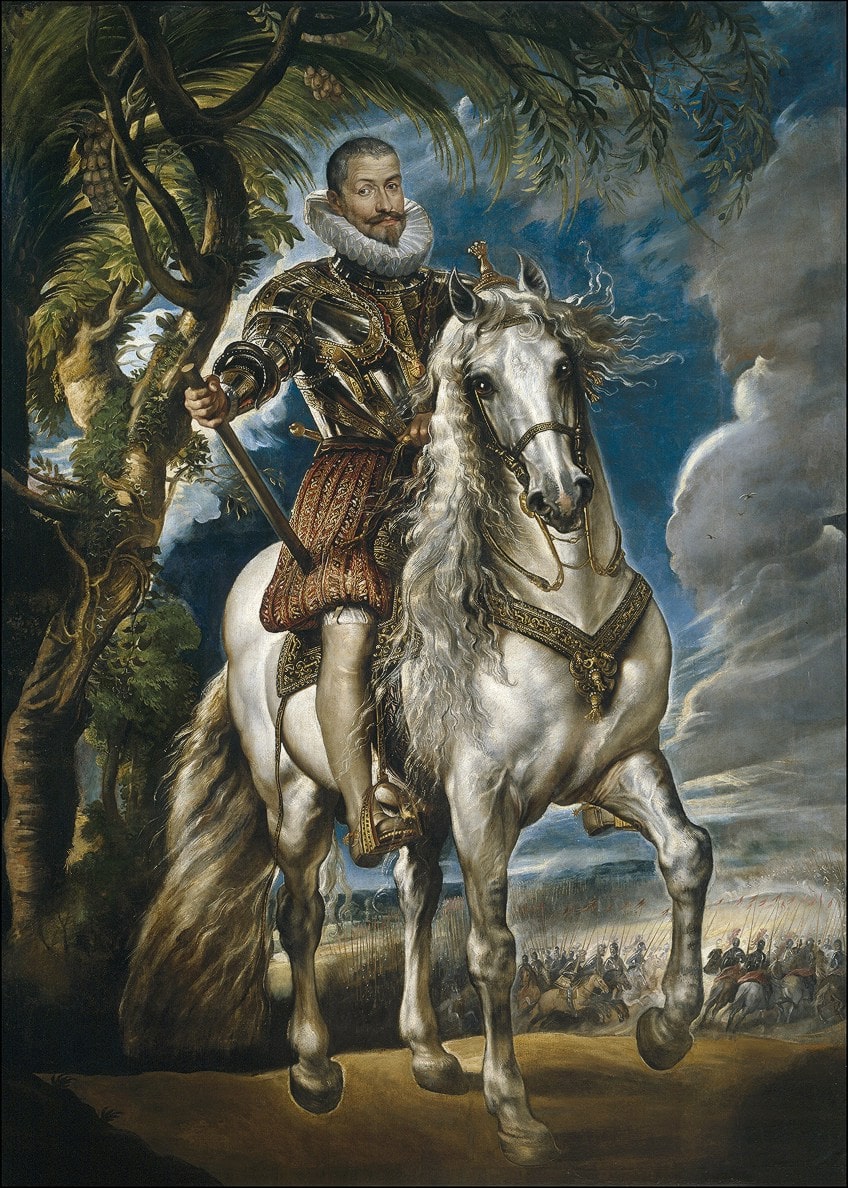
Rubens made sure to pay careful attention to all of the smaller elements in this painting, as well as the larger ones. The Duke’s soft collar accurately conveyed its delicateness, his armor was painted with a definite gleam, and the glossy coat, mane, and bridle of the horse added to its true-to-life depiction. These details proved to be crucial elements of the Baroque style, which helped make his artworks timeless.
Through the structure that Rubens used in this painting, he ended up creating the model that all future equestrian portraits were based on.
Honeysuckle Bower (1609)
| Date | 1609 |
| Medium | Oil on panel |
| Dimensions | 178 cm x 136.5 cm |
| Movement | Baroque |
| Where It Is Currently Housed | Alte Pinakothek, Munich |
After spending eight years in Italy, Rubens returned to Antwerp in 1609 and married his first wife, Isabella Brant. He created Honeysuckle Bower as a self-portrait of the couple just prior to their wedding. As far as portraits go, Rubens’ artwork is considered to be quite impressive, as he made use of a full-length canvas to depict two individuals.
The couple is positioned sitting in a branch of honeysuckle, which is where the title of the painting came from. Despite their large age difference, Rubens and his wife pose as a respected couple here.

The clothing worn by Rubens and Isabella presented them as a highly esteemed middle-class couple. When looking at the two outfits, Rubens’ look is more subdued when compared to his wife. He simply wears a coat that implies a gentlemanly sophistication, while his wife wore a lavish and magnificently embroidered dress in wine-colored taffeta silk, complete with a large frill ruff and a hat. The location of the painting was thought to be the inner courtyard of their home, where Isabella planted gardens of flowers and vegetables.
Holding hands, Rubens and his wife subtly lean towards each other while maintaining their courteous gaze towards viewers.
Various symbols of love and marriage can be seen surrounding the couple in the painting. Both the honeysuckle tree and the outdoor garden were considered to be traditional symbols of love, whilst the holding of each other’s right hand represented Rubens and Isabella’s union through marriage. The tender and loving approach that Rubens took with this painting echoed the intimacy of the occasion together.
The Raising of the Cross (1610 – 1611)
| Date | 1610 – 1611 |
| Medium | Oil on wood |
| Dimensions | 462 cm x 341 cm |
| Movement | Baroque |
| Where It Is Currently Housed | Cathedral of Our Lady, Antwerp |
The first altarpiece that makes the list of most famous Peter Paul Rubens artworks is The Raising of the Cross. After his return to Antwerp, Rubens was commissioned to paint this major altarpiece in 1610 and completed the enormous work a year later. As the painting was derived from the biblical allegory from the Gospel of Matthew, Rubens depicted Christ on his Crucifix as it was being lifted into an upright position.
Before beginning the painting of the piece, many initial “The Raising of the Cross” Rubens sketches were made by the artist.
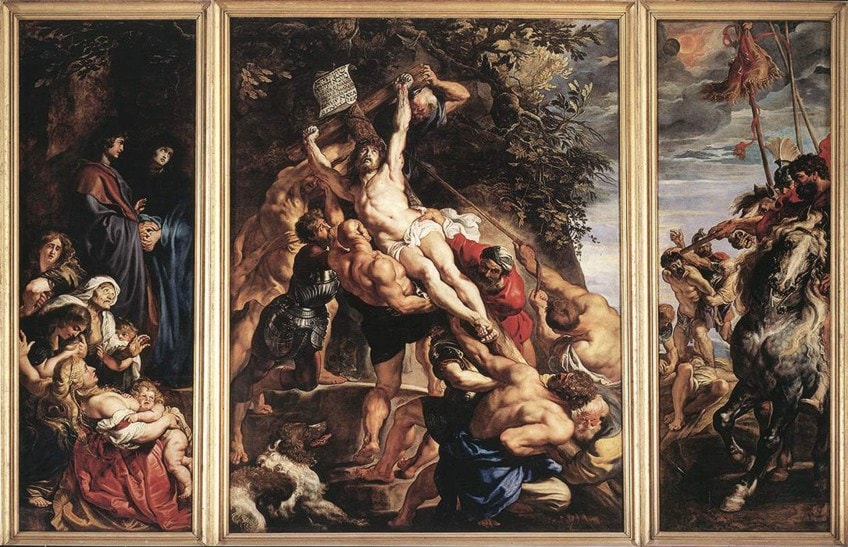
The central panel contains Christ as the focal element, as it represents the extremely tense and emotionally charged pinnacle of the painting. The two side panels, which consist of onlookers to the main scene, display the intense and impassioned reactions of those who were grieving on the left, as well as the two thieves who were next to be crucified on the right. The central panel shows the burst of action and intensity around Christ, with the technique of diagonal foreshortening heightening a scene already filled with strong tension.
While the central panel makes up the general focal element, the emphasized body of Christ exists as the main focal point. As he is surrounded by brawny men who battle to lift, push, and pull the heavy burden, the scene demonstrates the intense physical and emotional strain that was experienced while their eyes and appearances express utter disbelief and terror.
This immense artwork consists of a triptych that measures 15 feet high by 21 feet wide and was located above the high altar in a Gothic church so that it could be seen from the bottom.
Massacre of the Innocents (1611 – 1612)
| Date | 1611 – 1612 |
| Medium | Oil on oak |
| Dimensions | 142 cm x 182 cm |
| Movement | Baroque |
| Where It Is Currently Housed | Art Gallery of Ontario |
Depicting another biblical scene, Massacre of the Innocents was painted by Rubens in 1611, after his eventual return to Antwerp following eight years spent in Italy. Portraying the story from the Gospel of Matthew where King Herod demanded the execution of all male infants in Bethlehem after he heard that a child born there would become “King of the Jews”, Rubens’ painting became a very well-known artwork.
Though the scene is horrific, Rubens’ portrayal of women banding together to prevent soldiers from killing their children is very powerful.
The focal element of Massacre of the Innocents is the intense group of bodies meshed together that are fighting one another. Depicting the men as mostly naked and incredibly muscular, Rubens demonstrated the true strength and power that these women possessed to put up a fight against the brawny soldiers. Despite the men’s force, they are seen struggling against the women. This is further demonstrated by the flailing arms that try to reach for anything, as well as the blood that flows quietly while the adults fight over the children.
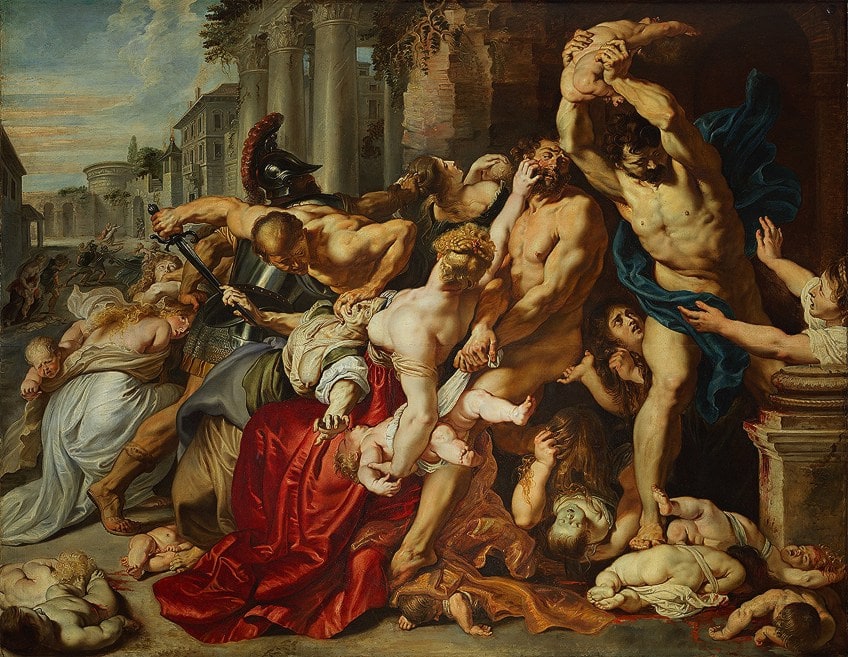
When viewing Massacre of the Innocents, a scene of frantic effort is produced because no matter how passionately these women fight to stop the slaughter, their efforts are already doomed. While most mothers continue to fight, others cry for the babies that are already dead. Rubens’ intent behind this painting was to unnerve the public, as he presented a violent image of war and loss that created a massive outrage.
The techniques used highlight Rubens’ time in Italy, as he was influenced by various Baroque painters, including Caravaggio.
The Hippopotamus Hunt (1615 – 1616)
| Date | 1615 – 1616 |
| Medium | Oil on canvas |
| Dimensions | 248 cm x 321 cm |
| Movement | Baroque |
| Where It Is Currently Housed | Alte Pinakothek, Munich |
Commissioned by Maximilian I, Elector of Bavaria, in 1615, The Hippopotamus Hunt was made to decorate the Schleißheim Palace outside of Munich. As one of the most iconic Peter Paul Rubens paintings made, this large artwork was made to accompany three other works depicting a lion, wolf, and boar hunts.
Depicting a hunt taking place on the banks of the Nile River, Rubens went on to create a wild battle between the hunting party and their intended prey.

Three of the men are portrayed as noblemen who were attempting to kill the crocodile and hippopotamus. Hunters atop Arabian horses are also seen, wielding swords and spears in an attempt to help slaughter the prey. Despite the action surrounding the battle taking place, one of the men lies dead and unmoving underneath the crocodile. His presence adds some stillness to an otherwise chaotic scene. However, this stillness is soon broken, as the rest of the party, complete with three hunting dogs, continues to launch an attack on the beasts.
This artwork captured Rubens’ use of motion and drama in his paintings, as the bright color palette depicting the intensity of the battle can be seen in his other works.
When creating this epic scene of struggle between man and beast, Rubens paid careful attention to the details that marked the men’s and animals’ appearances. While a fight between men and animals is seen, Rubens implied that the hunt represented humanity’s struggle with nature. Although he was renowned for his hunting scenes, this marked the end of his long focus on the theme.
The Head of Medusa (c. 1617 – 1618)
| Date | c. 1617 – 1618 |
| Medium | Oil on canvas |
| Dimensions | 69 cm x 118 cm |
| Movement | Baroque |
| Where It Is Currently Housed | Kunsthistorisches Museum, Vienna |
The Head of Medusa exists as another well-known Rubens painting, which he created between 1617 and 1618. Depicting the decapitated head of Medusa with her serpentine locks monstrously writhing around on a stone ledge, Rubens captured the wide-eyed horror and deathly pallor of her face in death. On the ledge, some of her intertwined snake locks are still alive and are seen biting one another. Other reptiles in the image, like two spiders, a scorpion, and a brightly colored lizard, are seen keeping their distance from the severed head.
Despite being presented with a particularly violent image, the focal point of this work lies in the gruesome expression on Medusa’s face, as well as the blood seeping out of her ruptured neck.
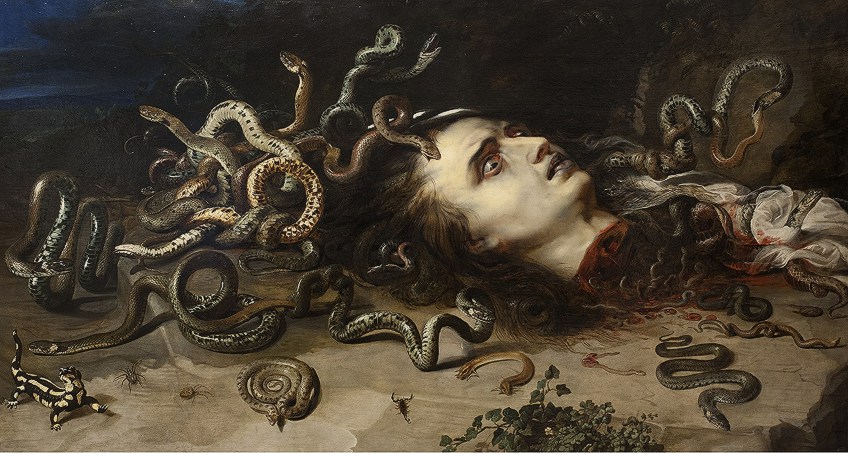
The bright red used to depict her blood stands out against the overall paleness of the work and instantly reminds viewers that they are witnessing a scene containing death. Drops of Medusa’s blood transform into tiny vipers that try to wriggle away, even though there is nowhere for them to really go apart from the ledge they are on.
According to the Roman poet Ovid, Medusa was the loveliest of Phorcys’s daughters and was especially adored for her gorgeous hair. However, after being violated by Neptune, Minerva turned her hair into a knot of vicious snakes. From then onwards, those that gazed upon Medusa’s face would turn to stone.
Traditionally, depictions of Medusa were commonly presented with a shield so as to honor the legend of not being able to look directly at her face. In Rubens’ version, he subverted this by displaying Medusa’s face for all to gaze upon.
The Rape of the Daughters of Leucippus (c. 1618)
| Date | 1618 |
| Medium | Oil on canvas |
| Dimensions | 224 cm x 209 cm |
| Movement | Baroque |
| Where It Is Currently Housed | Alte Pinakothek, Munich |
Creating this incredible life-sized painting around 1618, The Rape of the Daughters of Leucippus exists as a very well-known work of Rubens. In most of his classic artworks, Rubens demonstrated an attempt to match the elegance and heroic magnificence seen within most Renaissance art, with this painting being no exception.
Rubens’ inspiration behind this work was based on a mythical story that was told by poets Theocritus and Ovid, which illustrated what happened to the two daughters of King Leucippus.
The story goes that the daughters of King Leucippus, Hilaeira and Phoebe, were engaged to the twin brothers of Thebes, Lynceus, and Idas. However, before they married, the girls were abducted by another set of twins, Castor and Pollux, who were set on marrying them.
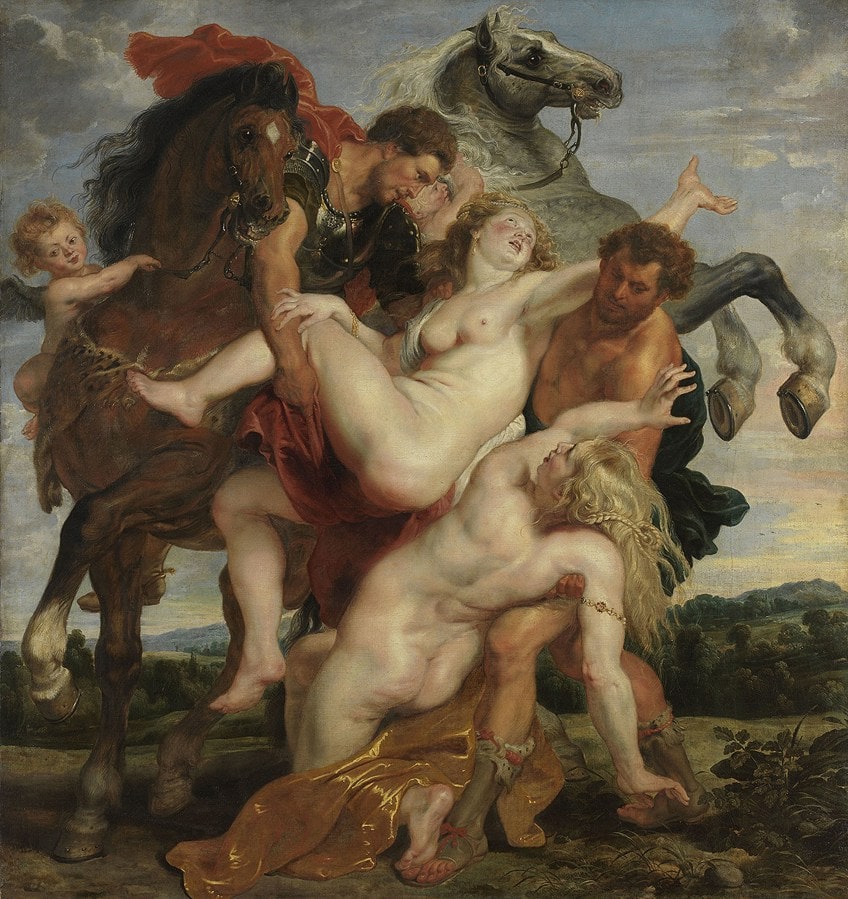
To enforce their will upon the daughters, Castor and Pollux carried them off to Sparta where they were promptly married before the girls gave birth to sons. In the painting, armed warriors are seen capturing the unclothed daughters and pulling them away on horseback.
Castor, identified by his armor and docile horse, grabs the struggling Hilaeira while Pollux, recognizable from his naked chest and wild horse, wrestles with Phoebe. Despite the violence in the scene, Rubens arranged the horses and figures in such a precise way that they helped create a dynamic yet balanced image. The figures, which are interlocked, fight against one another and create two distinct diagonals with their bodies which helps viewers follow the action of the painting.
In classical mythology, the term “rape” was used to refer to abduction.
Prometheus Bound (1618)
| Date | 1618 |
| Medium | Oil on canvas |
| Dimensions | 243.5 cm x 209.5 cm |
| Movement | Baroque |
| Where It Is Currently Housed | Philadelphia Museum of Art, Philadelphia |
Based on the Greek play Prometheus Bound, this classical painting of the same name can be added to the list of most famous Peter Paul Rubens paintings. According to the legend of the demigod Prometheus, he gave the secrets of fire to man, which was not allowed. Zeus responded by punishing him and chaining him to a rock, whereby an eagle would feast upon his flesh every day.
In this work, Rubens depicted Prometheus shackled on Mount Caucasus, while the vicious eagle of Jupiter, a known symbol of Zeus, is seen feeding upon his liver.

When creating this painting, Rubens was inspired by an artwork of Titian and went on to create a fairly dense composition. This heaviness can be seen through the way in which Prometheus plunges towards the bottom of the image, with his left arm almost extending outside of the canvas. Most of the composition is made up of Prometheus’s muscular body, which Rubens painted using the technique of foreshortening.
Additionally, the powerful eagle takes up the rest of the space through the span of its outstretched wings.
While the background is of secondary importance, Rubens created a beautiful and peaceful backdrop to juxtapose against the fairly intense scene of Prometheus and the eagle. As the bird viciously rips open Prometheus’s torso, one of its talons painfully gouges into his eye to better grasp its prey. His left eye, which is focused on the predator, demonstrates that Prometheus is acutely aware of his torture, with his twisting body and clenched posture clearly conveying the great pain he is in.
Marie de’ Medici cycle (1622 – 1624)
| Date | 1622 – 1624 |
| Medium | Oil on canvas |
| Dimensions | Various |
| Movement | Baroque |
| Where It Is Currently Housed | Louvre Museum, Paris |
Known as the largest commission of Ruben’s career, the Marie de’ Medici cycle is definitely on the list for the most famous Peter Paul Rubens artworks of all time. Towards the end of 1621, Rubens received a commission for 24 paintings from Marie de’ Medici, the widow of Henry IV of France. These works were to depict the struggles and triumphs in the life of the Queen Mother of France and were expected to be finished in two years to correspond with the wedding of Marie’s daughter, Henrietta Maria.
After completing this series, Rubens solidified his status as a revered artist in Europe.
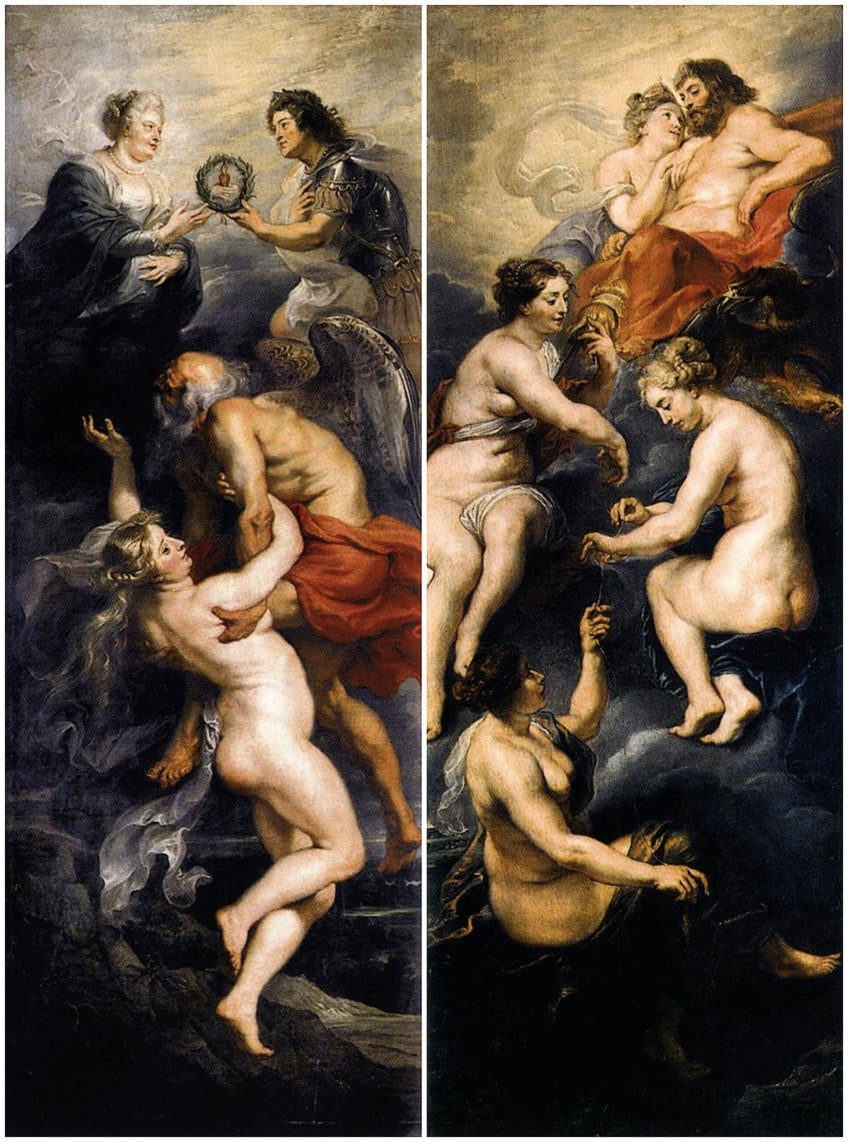
While the paintings were meant to immortalize the queen’s life, Rubens struggled initially as her life fell short of any significant accomplishments and events. In order to create paintings that would be accepted, Rubens made use of his comprehensive knowledge of mythology and allegorical representation to exaggerate her life’s achievements. Many of the paintings feature images and emblems from Greek and Roman mythology, as well as from the Bible.
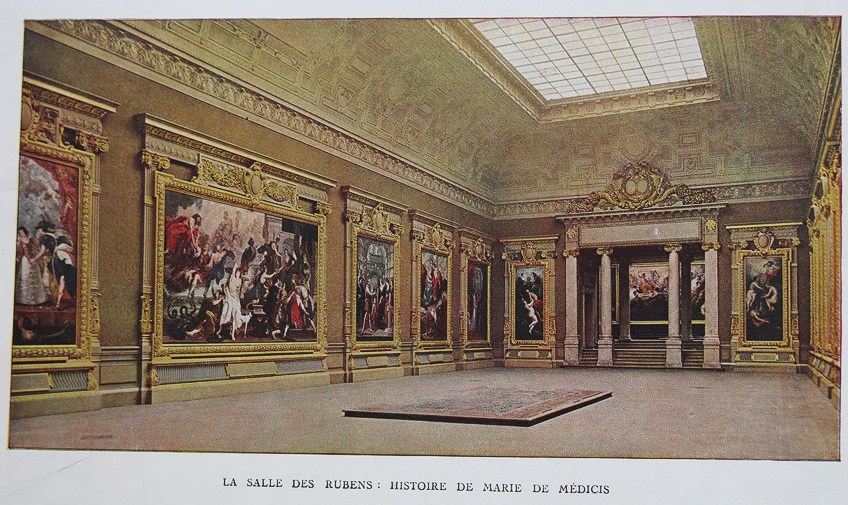
Most of the images focus solely on the queen’s life, while the final three portraits depict herself and her parents. This imposing and ostentatious project, which was designed in truly daring proportions, was thought to have been commissioned to equal another renowned series of Rubens’, The Constantine Tapestries (1622 – 1640).
As this series was such a monumental undertaking, Rubens hired assistants to paint the backgrounds and details to accelerate the process. However, he was legally bound to paint all of the impressive figures himself.
The Adoration of the Magi (1624)
| Date | 1624 |
| Medium | Oil on panel |
| Dimensions | 218 cm x 280 cm |
| Movement | Baroque |
| Where It Is Currently Housed | Royal Museum of Fine Arts, Antwerp |
Another altarpiece commissioned to Rubens by St. Michael’s Abbey in Antwerp was The Adoration of the Magi, which he painted in 1624. Following the biblical story from the book of Matthew which centers around the Adoration of the Magi, Rubens was known to paint at least 12 different paintings of this scene, as it became his most painted episode from the life of Christ.
Additionally, this was also one of Rubens’ personal favorites to paint. This painting remains a notable symbol of the times as it represented a modest world before the Church.
In this specific interpretation, Rubens depicted three Magi. These figures illustrated all of the lands and people that had heard about the birth of Christ and came with gifts for the child. As the entire group gazes at a very tranquil-looking Mary, she is seen as one of the important focal points in the work. The other significant focus is the central figure kneeling towards Christ, who is identified as Gaspar. Dressed in white, Gaspar offers a gift of frankincense for Jesus and places it on a pillow before him.

Rubens presented a very colorful group in The Adoration of the Magi, as seen through the brightly colored robes worn by everyone. It was said that Rubens most likely modeled the Virgin Mary after his first wife, Isabella Brant. This painting existed as an enormous artwork of Rubens that was completely overwhelming when viewed.
Rubens made use of signature Baroque techniques in his work, such as brushstrokes that were able to keep the vitality flowing around the many figures who were there honoring the birth of Jesus.
Venus and Adonis (1635 – 1638)
| Date | 1635 – 1638 |
| Medium | Oil on canvas |
| Dimensions | 197.5 cm x 242.9 cm |
| Movement | Baroque |
| Where It Is Currently Housed | Metropolitan Museum of Art, New York City |
Taking the subject of his painting from Roman poet Ovid’s Metamorphoses, Rubens created Venus and Adonis between 1635 and 1638. The ancient myth tells the sad story of Venus, who was accidentally pricked by one of Cupid’s arrows and falls in love with a handsome but mortal hunter, Adonis. Despite this, Adonis remained casually indifferent to Venus’s charms and warnings of danger and continued to hunt, eventually being stabbed to death by a wild boar. In Rubens’ artwork, he displayed the scene of their farewell before they parted ways.
When looking at the work, the three figures in the middle command our attention, as Venus, Adonis, and Cupid are seen to be intertwined.
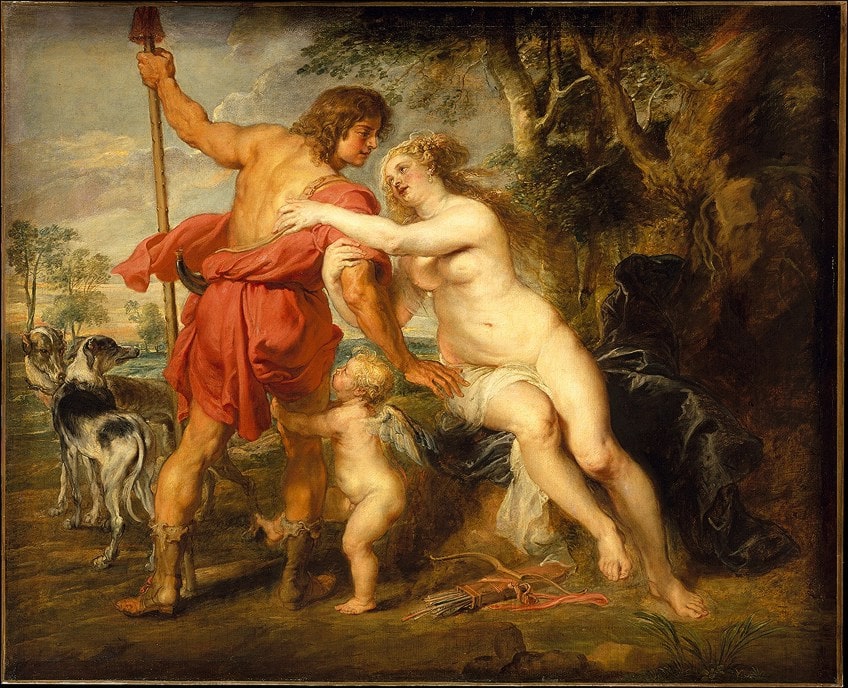
From her seat at the base of a tree, the naked Venus gracefully leans in towards the center of the composition to beg Adonis to stay. She delicately pulls him towards her with an imploring expression on her face, while the infant god of love tugs at his right leg tightly in an effort to keep him safe. Wearing two small pieces of cloth and one smooth pearl teardrop earring, Venus appears as a luscious goddess.
By contrast, Adonis appears as the ultimate embodiment of a perfect Greek sculpture, with his muscular limbs emphasizing the power and vitality of his young body.
Wearing a vibrant red robe, Adonis stands out greatly in comparison to the light blue sky and the pale Venus and Cupid. Although he is about to walk away, Adonis and Venus create a huge central triangle through their arms that are connected, which sits in the middle of the composition. In this space, the clothing and expressions of the two remain tender, gentle, and loving.
The Three Graces (1639)
| Date | 1639 |
| Medium | Oil on oak |
| Dimensions | 221 cm x 181 cm |
| Movement | Baroque |
| Where It Is Currently Housed | Museo del Prado, Madrid |
The final painting included on our list of most famous Peter Paul Rubens artworks is The Three Graces, which was painted in 1639. Taking another story from Greek mythology, Rubens presented the Three Graces, who were the goddesses and daughters of Zeus. He portrayed this theme several times throughout his career but later changed his style so that it triumphed in classical antiquity. The Three Graces was in fact one of the final artworks that Rubens produced, with the painting staying in his personal collection until he died.
In Rubens’ artwork, the three goddesses are shown to be linking arms to form a tight circle so that one of them had their back to the audience.

According to the ancient story, these divinities who were known as Aglaia, Euphrosine, and Thalia, were virgins who were of service to the goddess Aphrodite and worked at banquets to promote and encourage the pleasure of life. Known as the goddesses of friendly charm, generous acts, and gratitude, they gave people the attributes of amiability, powerfulness, loveliness, and great conversation.
With their translucent skin giving the goddesses an apparent glow, their bodies seem to shine like a light that draws viewers into the artwork. Despite wearing nothing except for some transparent scraps of draping, the Three Graces appear to be completely comfortable as they gracefully move with one another around their beautiful and picturesque environment. The goddesses are framed into the center of the composition by the tree on the left, the golden cornucopia on the right, and by the charming garland of flowers that hang above them.
Throughout his long career, Peter Paul Rubens went on to create several very iconic artworks. Most of his paintings were incredibly beautiful and elegant to look at, as they depicted mostly biblical stories and mythological fables. In the last 10 years of his life, Rubens focused exclusively on themes of mythology, which led to his signature mastery of the female nude form that would garner him global acknowledgment. If you have enjoyed reading about the above Peter Paul Rubens paintings, we encourage you to research others.
Take a look at our Rubens paintings webstory here!
Frequently Asked Questions
Were Any Rubens Drawings Ever Made?
As an artist, Rubens was known for the impressive paintings that he produced as a court painter for the Austrian royal family, as well as the artworks that he was commissioned to make. Despite this, before undertaking some of his greater and more challenging works, Rubens would sketch his compositions out. These preliminary markings became known as Rubens drawings; however, he would always paint over them to complete his artwork.
What Is So Iconic About The Elevation of the Cross Rubens Sketches?
In 1611, Rubens was commissioned to create a triptych of The Elevation of the Cross for the Church of St. Walburga. Rubens also created a much smaller oil on paper painting depicting the same scene, which is viewed as one of his sketches for the larger artwork. As the original church for which Rubens created his painting has since been destroyed, the triptych now hangs in the Cathedral of Our Lady in Antwerp, while the paper painting is located at the Louvre Museum in Paris.
Isabella studied at the University of Cape Town in South Africa and graduated with a Bachelor of Arts majoring in English Literature & Language and Psychology. Throughout her undergraduate years, she took Art History as an additional subject and absolutely loved it. Building on from her art history knowledge that began in high school, art has always been a particular area of fascination for her. From learning about artworks previously unknown to her, or sharpening her existing understanding of specific works, the ability to continue learning within this interesting sphere excites her greatly.
Her focal points of interest in art history encompass profiling specific artists and art movements, as it is these areas where she is able to really dig deep into the rich narrative of the art world. Additionally, she particularly enjoys exploring the different artistic styles of the 20th century, as well as the important impact that female artists have had on the development of art history.
Learn more about Isabella Meyer and the Art in Context Team.
Cite this Article
Isabella, Meyer, “Peter Paul Rubens Paintings – The Best Rubens’ Artworks.” Art in Context. November 1, 2021. URL: https://artincontext.org/peter-paul-rubens-paintings/
Meyer, I. (2021, 1 November). Peter Paul Rubens Paintings – The Best Rubens’ Artworks. Art in Context. https://artincontext.org/peter-paul-rubens-paintings/
Meyer, Isabella. “Peter Paul Rubens Paintings – The Best Rubens’ Artworks.” Art in Context, November 1, 2021. https://artincontext.org/peter-paul-rubens-paintings/.


